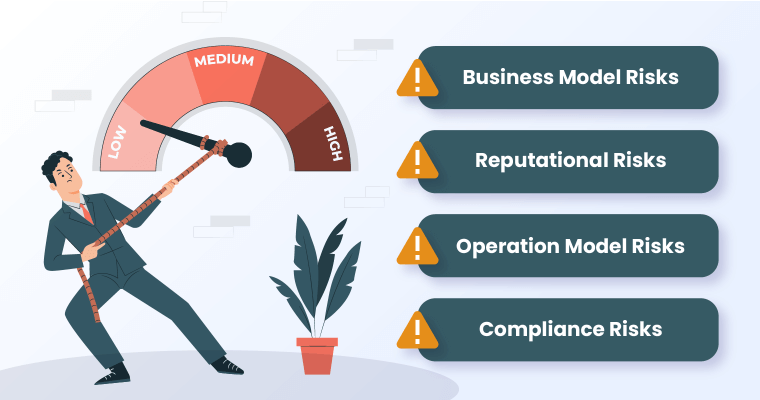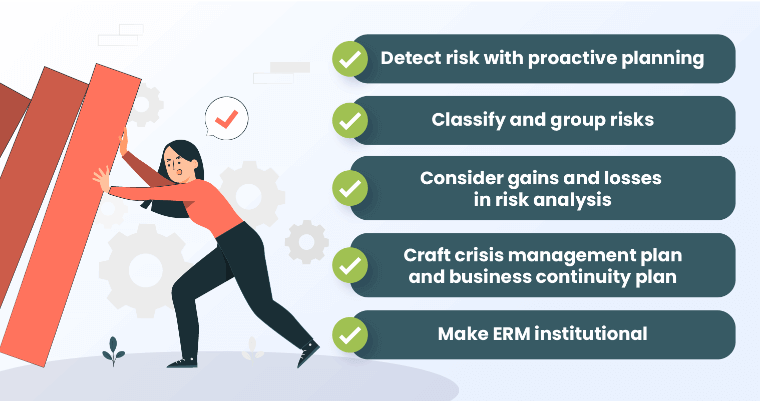Just like any other organization, universities and higher education institutions deal with risks. The risks that universities commonly face are rooted in financial limitations, cybersecurity vulnerabilities, academic program disruptions, and compliance challenges. Given the rapid rate of digitalization and shifts in the market, businesses are finding it rather challenging to adapt to evolving risk landscapes. Higher education institutions must embrace a proactive approach to risk management that promotes foresight and adaptability if they want to stay competitive.
This article explains how Enterprise Risk Management (ERM) transforms the way risk management is conducted in higher education institutions. Find out how universities can effectively implement ERM in their organizations.
What is enterprise risk management (ERM)?
Enterprise risk management (ERM) is the systematic and holistic management of risks within an enterprise. It entails proactively identifying risks related to operations, finance, reputation, and compliance that may hinder enterprises from achieving their long-term objectives. High-ranking executives lead ERM, unlike the siloed and departmentalized approach of traditional.
There are ERM frameworks that senior leaders can select from that can help them assess and study the risk appetite and thresholds of their organization. Depending on the university’s size and culture, they can select from:
- Casualty Actuarial Society (CAS)
- Committee of Sponsoring Organizations of the Treadway Commission (COSO)
- International Organization for Standardization (IOS)
- Risk Management Society (RIMS)
Organizations that are successful in implementing the higher education risk management framework are committed to the closed-loop cycle of risk detection, assessment, and mitigation. Through this process, higher education boards can stay proactive when managing risks.
Why is ERM important for higher education boards?
Enterprise risk management higher education institutions offer a structured framework helpful for the board to effectively identify and mitigate risks. It empowers the board to make risk-aware and sound decisions that align with the best interests of the university. Higher education boards value ERM for the following reasons:
Cultivate Risk-Focused Culture
When top management openly discusses how they handle risks and asks for feedback from employees, the concept of risk management in universities becomes more relatable. ERM champions the integration of risk management into strategy planning. The localization of risk discussion allows the board, executives, and teams to weigh the implications of their decisions before making them.
Cultivating a risk-focused culture not only prevents negative outcomes but also embeds the mindset of innovation and adaptability in individuals. It empowers them to be more critical and proactive when addressing issues in their day-to-day work.
Standardize Risk Audit and Report
ERM motivates higher education boards to adopt standardized risk auditing and reporting to aid in the analysis of evolving risk libraries. Risk managers can use this valuable information to determine the institution’s risk appetite, tolerance, and threshold. These are crucial considerations when developing risk management plans. It commonly includes actionable data on key risk indicators, new and emerging risks, and risk management index.
Streamline Resource Management
ERM reduces the overall cost of risk management in higher education over time because it guides the boards to form holistic enterprise-wide solutions that address risks at their shared root causes. ERM encourages higher education institutions to avoid implementing risk mitigation programs in siloes, instead always looking into the bigger picture of how risks develop across departments to avoid duplication of effort and prevent wastage of resources. As ERM becomes deeply ingrained in the organization, teams will better understand the interconnectedness of risks and develop the ability to effectively mitigate them holistically.
Types of Higher Education Risks
Multiple risks can impact the capacity of an institution to execute its plans and achieve its goals. These risks can be broadly categorized into several types:
Business Model Risks
A business model shows how an institution plans to deliver value and generate profit, and any factors that can compromise their ability to earn are called business model risks. These risks stem from inherent weaknesses in an institution’s core aspects often related to products or services, ineffective partnerships, or misaligned business systems.
New businesses may face risks early on due to inherent weaknesses that were not identified from the start, such as irrelevant offerings and unsustainable profit streams. On the contrary, existing businesses are not exempted from this and are still prone to risk.
Older business models are often challenged by the rapid market shifts that require them to adapt to the changing customer demands and evolving business landscapes. Therefore, business models must evolve as demands and requirements change over time. The capacity of a business to stay relevant and competitive is a strong predicament of its agility and resilience to business model risks.
Reputational Risks
Institutions of higher education are often lauded for their prestige, excellence, and esteemed recognition. These characteristics are what draw students to enroll, alumni to return, and professors to apply. To put it simply, their market share is a reflection of their influence and reputation. External and internal factors that can stain the reputation and damage the market share of an institution are called reputational risks.
The most common reputational risks in higher education are campus climate, sexual assaults, academic programs, and student behavior. In an era in which social media can shatter or strengthen a reputation in a matter of minutes, institutions must manage reputational risk as part of their overall ERM strategy. Higher education boards can build their resilience against reputational risks by cultivating an inclusive culture within the campus and preparing a comprehensive portfolio of every risk and its mitigation plans.
Operation Model Risks
Poor resource management, lack of technology, and staffing shortages are common examples of operational model risks. Inadequate mitigation of these risks can result in weak operational infrastructures that can negatively impact the ability of the board to respond to market changes.
This eventually affects the enterprise’s profitability and reputation because of its subpar results and ineffective operations. To manage these types of risks, higher education boards must keep strong internal controls and sound policies for resource management and detecting operational irregularities.
Compliance Risks
Strong adherence to legislative compliance helps higher education institutions preserve their reputation and the trust of their stakeholders. A compliant institution has a rigorous risk management strategy that assesses intricate and changing laws for a streamlined implementation across departments. Poor compliance often escalates to serious legal risks such as monetary fines, loss of accreditation, and criminal charges.
Enterprise Risk Management Best Practices for Higher Education

The dynamic risk landscape urges higher education boards to prepare for not only traditional risks, but also more advanced ones such as cybersecurity breaches, health crises, and geopolitical instability. To risk-proof institutions, boards must build an agile ERM system that combines foresight and technology. Here are ERM best practices to enhance risk awareness.
Detect risk with proactive planning
Detecting risks before they become disruptive is called proactive planning. To develop enhanced risk visibility, all risk types present in institutions should be documented in risk portfolios, regardless of their likelihood or potential impact.
For example, risk managers should consider the risk of building hazards as important as cybersecurity threats and natural disasters. Through this meticulous approach, risk managers can explore different angles and gain a comprehensive foundation for developing well-rounded risk mitigation plans.
Here are questions your team can use when evaluating risks:
- What are the top risks?
- To what extent are these risks likely to materialize, and how severe is their impact?
- How often does the organization refresh its risk management plan?
- Does the board of directors have the skill set to conduct effective risk oversight?
- Does the current risk reporting deliver the necessary information to the board for risk management?
Classify and group risks
Risks are inevitable and become increasingly present in higher education institutions as they evolve and adopt innovations. Because risks are everywhere, higher education boards must set up a well-structured risk management system to anticipate and manage risks as they arise.
Risk classification is an essential phase in risk management in education that groups risks based on potential impact, type, and urgency. This process helps teams familiarize themselves with various risk types and prepares them to develop mitigation plans effectively.
Consider gains and losses in risk analysis
Much of the conversation surrounding enterprise risk management in higher education institutions concerns only the potential negative outcomes — loss of money, data theft, and health and safety threats. It is a given that potential losses from poor practice or investment can be catastrophic.
However, risk also presents potential positives, and these should be considered in any risk analysis or ongoing monitoring. Financial risk often has as much chance of successful investment as financial loss. A new IT infrastructure system has more chances of reducing productivity than increasing it.
Craft crisis management plan and business continuity plan
Planning is an essential component when running any business; It dictates how an organization can prepare for, respond to, or recover from unlikely situations. A study released by Forbes revealed that 49% of companies in the US have formal crisis communication plans, showing a gap in business preparedness. Risk and crisis managers should focus on strengthening the resilience of their institutions in today’s competitive landscape.
Universities need a Crisis Management Plan (CMP) and a Business Continuity Plan (BCP) incorporated into their ERM program. CRM is a detailed plan designed to lessen the impact of a crisis in an organization, while BCP outlines how businesses should proceed after a crisis to avoid downtime and ensure continuity. Both significantly enhance ERM by fortifying it with comprehensive plans that touch on aspects often overlooked by traditional risk assessments.
Make ERM institutional

Enterprise risk management impacts every area of higher education. Aim to raise awareness about the risk of every action in the enterprise, and the positive and negative consequences, at all levels. Prioritizing tasks, and understanding legal and corporate responsibility to students, faculty, employees, and visitors can help mitigate the potential negative consequences of most risk factors.
Ideally, invest in training your staff to understand risks associated with their jobs and general risks over which they might have limited control. Provide training programs and refresher courses so your staff can have a better grasp of ERM best practices.
ERM in higher education, however, should not stop there. Make it an ongoing process with regular checks, updates, and reviews to see how the existing system might be improved. No system is perfect, there will be problems even with a robust framework. Learn the lessons from the successes as well as the failures.
Frequently Asked Questions About ERM for Higher Education
Read these frequently asked questions to learn more insights into ERM best practices for higher education.
What are the five components of enterprise risk management?
Company Culture, Governance, and Values
The success of ERM lies in how management aligns its culture, values, and university governance to ERM principles. The setting of tone, mindset, and objectives should come from the top and create a ripple effect to the downlines. Therefore, ERM implementation necessitates strong-willed governance to effectively persuade the institution to be accepting of new methods and strategies.
Strategic Planning, Objectives, and Goal Setting
Effective risk management is unlikely if there is no defined strategy communicated to the entire institution. This is an opportune time to select an ERM framework best fitting the business model, establish boundaries for risk prioritization, and identify the risk appetite and thresholds of the institution. Decision-making and strategy planning would be easier if these factors were set from the onset.
Risk Management Cycle
This component deals with risk identification, assessment, and mitigation. In creating a sustainable risk management cycle, management should devise a strategy that can combine the three phases seamlessly. The closed loop allows them to proactively detect risks and mitigate them, increasing their adaptability and resilience.
Monitoring and Continuous Improvement
ERM demands continuous monitoring and is not a one-time implementation. To stay aligned with the dynamic market behavior and remain competitive, the program has to adapt to evolving risk profiles. In this stage, senior leaders have to build a system that integrates ERM into the overall strategy of the institution to ensure that the program runs long.
Transparency, Communication, and Reporting
Communication between management and stakeholders must be part of the risk management cycle. Senior leaders would present ERM reports on program performance, risks, and mitigation strategies. Stakeholders must be open to providing feedback to help decision-makers pinpoint areas of improvement. Ultimately, senior leaders should promote transparency with stakeholders and be receptive to feedback to foster open communication about risk within the institution.
How often should higher education institutions review and update their ERM strategies?
The frequency of reviewing and updating ERM strategies varies depending on the ERM framework, size, and culture of the institution. For example, ISO 31000 ERM Framework, recommends reviewing the framework every five years to keep pace with the evolving risk landscape.
However, it is common practice for higher education institutions to conduct at least an annual comprehensive review of their ERM strategies. These regular assessments ensure that ERM programs adapt well to changes often related to regulatory updates, evolving academic trends, and other external factors.
Is there a one-size-fits-all approach to ERM for higher education?
The implementation of ERM differs for each institution. ERM strategies are developed based on size, culture, and preferences, therefore, outcomes are different each time. For instance, while some higher education institutions can readily adopt existing ERM frameworks, others may need to develop their frameworks to better align with their specific needs.
Convene Empowers Higher Education Leadership and Risk Management

Empowered leadership and robust risk management are crucial in combating the escalating risks universities face today. University governance requires its boards to deliver a new level of collaboration and leadership to successfully mitigate reputational risks, financial pressures, and shifting student demands.
University trustees must rely on technology to optimize and strengthen their systems to overcome fragmented communication, inefficiency, and cybersecurity hazards. Implementing collaborative and leadership tools such as the Convene university board portal software, becomes essential. With Convene, boards and management can centralize the assignment of tasks, communication of goals, and dissemination of announcements.
With its real-time audit trail, fine-grained permission control, and resistant security features, Convene board portal management software is a tool to heighten the visibility of all contributors working towards a more resilient ERM and stable governance. Explore the advantages of Convene’s university board portal today!
Jess is a Content Marketing Writer at Convene who commits herself to creating relevant, easy-to-digest, and SEO-friendly content. Before writing articles on governance and board management, she worked as a creative copywriter for a paint company, where she developed a keen eye for detail and a passion for making complex information accessible and enjoyable for readers. In her free time, she’s absorbed in the most random things. Her recent obsession is watching gardening videos for hours and dreaming of someday having her own kitchen garden.











